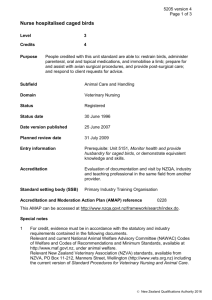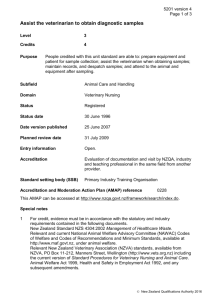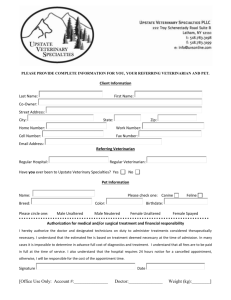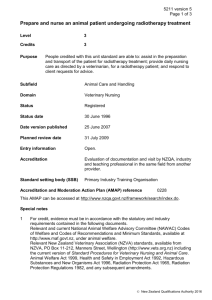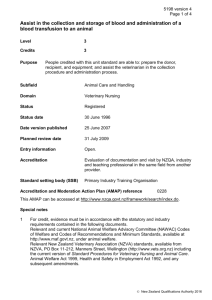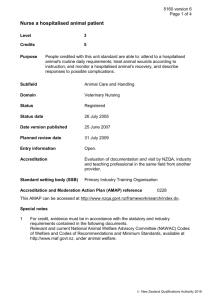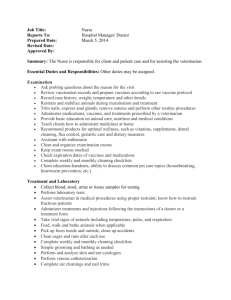5204 Assist the veterinarian with consultations and surgery involving
advertisement
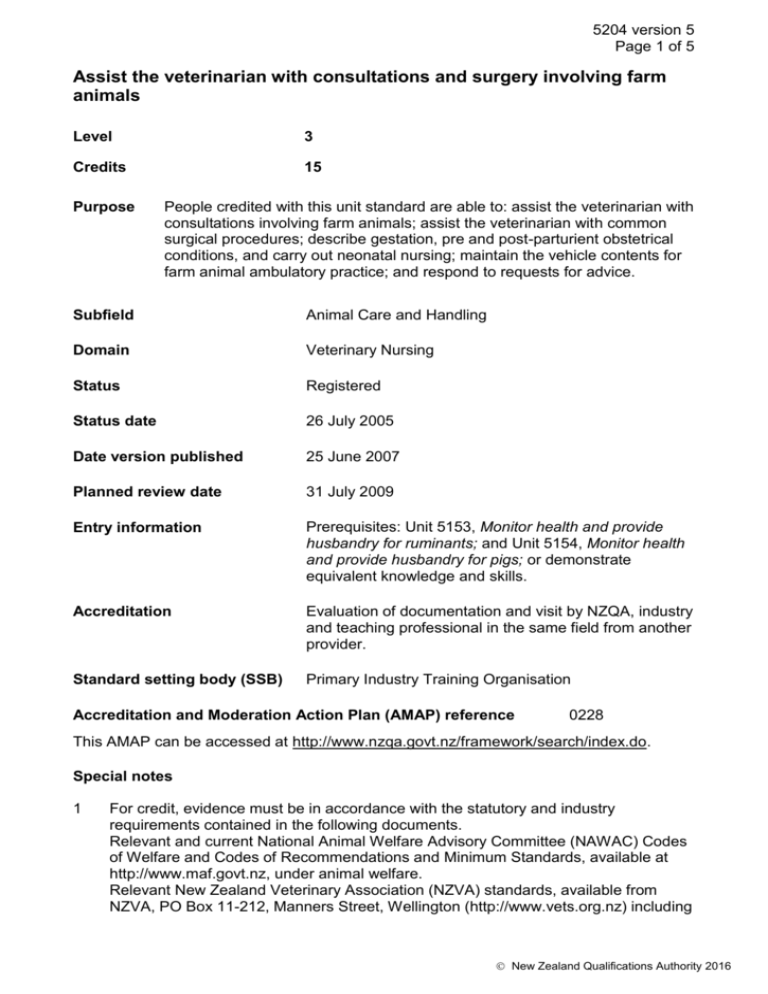
5204 version 5 Page 1 of 5 Assist the veterinarian with consultations and surgery involving farm animals Level 3 Credits 15 Purpose People credited with this unit standard are able to: assist the veterinarian with consultations involving farm animals; assist the veterinarian with common surgical procedures; describe gestation, pre and post-parturient obstetrical conditions, and carry out neonatal nursing; maintain the vehicle contents for farm animal ambulatory practice; and respond to requests for advice. Subfield Animal Care and Handling Domain Veterinary Nursing Status Registered Status date 26 July 2005 Date version published 25 June 2007 Planned review date 31 July 2009 Entry information Prerequisites: Unit 5153, Monitor health and provide husbandry for ruminants; and Unit 5154, Monitor health and provide husbandry for pigs; or demonstrate equivalent knowledge and skills. Accreditation Evaluation of documentation and visit by NZQA, industry and teaching professional in the same field from another provider. Standard setting body (SSB) Primary Industry Training Organisation Accreditation and Moderation Action Plan (AMAP) reference 0228 This AMAP can be accessed at http://www.nzqa.govt.nz/framework/search/index.do. Special notes 1 For credit, evidence must be in accordance with the statutory and industry requirements contained in the following documents. Relevant and current National Animal Welfare Advisory Committee (NAWAC) Codes of Welfare and Codes of Recommendations and Minimum Standards, available at http://www.maf.govt.nz, under animal welfare. Relevant New Zealand Veterinary Association (NZVA) standards, available from NZVA, PO Box 11-212, Manners Street, Wellington (http://www.vets.org.nz) including New Zealand Qualifications Authority 2016 5204 version 5 Page 2 of 5 the current versions of Standard Procedures for Veterinary Nursing and Animal Care (referred to in this unit standard as standard procedures); BESTPRACTICE™ Standards for Companion Animal and Large Animal Combined Module for Mixed Practices; and BESTPRACTICE™ Standards for Large Animal Practice Module. Animal Remedies (Develvetting) Regulations 1994, Animal Welfare Act 1999, Health and Safety in Employment Act 1992, and any subsequent amendments. 2 Definitions In-house procedures refer to the documented policies and procedures for animal care, handling, and ethical behaviour codes required by the employer, consistent with NZVA BESTPRACTICE™ standards. Farm animals, in this unit standard, refers to cattle, goats, sheep, pigs and deer. Elements and performance criteria Element 1 Assist the veterinarian with consultations involving farm animals. Range evidence for at least three species is required; evidence for all items in performance criteria ranges must be provided, but not necessarily for each species. Performance criteria 1.1 Animals are caught and restrained with minimum stress to the animal, and without injury to people or animal, to enable the veterinarian to administer medication. Range 1.2 Medication is administered, with minimum stress to the animal and minimum damage to hide/carcass, as directed by the veterinarian. Range 1.3 head bale, use of race, leg ropes, crush, nose grip, halter, restraint without equipment. subcutaneous injection, intramuscular injection, intravenous, intramammary, pessaries, oral paste or liquid, topical application to eye, topical application to skin. Ongoing nursing procedures are carried out as directed by the veterinarian. Range dressing, bandaging, checking vital signs (respiration, pulse, temperature, colour and hydration of mucous membranes, capillary refill time), medication, monitoring food/water intake, monitoring oestrous activity. New Zealand Qualifications Authority 2016 5204 version 5 Page 3 of 5 Element 2 Assist the veterinarian with common surgical procedures. Range evidence for at least three species is required; evidence for all items in performance criteria ranges must be provided, but not necessarily for each species. Performance criteria 2.1 Surgical procedures performed on farm animals are described in terms of health of animal and safety of personnel. Range 2.2 Assistance with local anaesthetic techniques associated with surgical procedures is provided, as directed by the veterinarian. Range 2.3 castration, dehorning, tailing, docking, disbudding, caesarean, velvetting. surgical procedures may include but are not limited to – castration, dehorning, tailing, docking, disbudding, caesarean. Assistance is provided, maintaining sterility and a clear surgical field during surgical procedure, as directed by the veterinarian. Range includes but is not limited to – restraining animal, positioning animal, passing instruments, holding instruments, counting instruments, retraction. 2.4 Assistance is provided in post-operative management of the animal as directed by the veterinarian. 2.5 Common post-operative complications are described in terms of their signs. Range includes but is not limited to – wound breakdown, primary and secondary infection, metabolic problems, myopathy, paralysis, fly strike. Element 3 Describe gestation and pre and post-parturient obstetrical conditions, and carry out neonatal nursing. Range evidence for at least one species is required. Performance criteria 3.1 Gestation and normal parturition are described in terms of their stages. 3.2 Situations and conditions requiring veterinary assistance are described in terms of gestation, during and post-parturition, and neo-natal conditions. New Zealand Qualifications Authority 2016 5204 version 5 Page 4 of 5 3.3 Routine management of the neonate is carried out to allow optimum opportunity for survival. Range environmental temperature control, nutrition, assisted feeding, supplementary feeding, hand rearing, mothering on. Element 4 Maintain the vehicle contents for farm animal ambulatory practice. Performance criteria 4.1 Vehicle is stocked according to practice inventory list and individual veterinarian’s requirements. 4.2 Stock levels are maintained according to usage and expiry dates. Element 5 Respond to requests for advice. Performance criteria 5.1 General enquiries are assessed to determine the most suitable person to deal with them. 5.2 Advice given is provided clearly and courteously, is accurate, and is within own capability and according to in-house procedures. Range 5.3 may include but is not limited to – vaccination schedules, parasite control, pregnancy management, post-surgical care, care of dressings, signs of imminent parturition, care of new born and mother. Need for referral to a specialist is assessed in accordance with in-house procedures. Please note Providers must be accredited by NZQA, or an inter-institutional body with delegated authority for quality assurance, before they can report credits from assessment against unit standards or deliver courses of study leading to that assessment. Industry Training Organisations must be accredited by NZQA before they can register credits from assessment against unit standards. Accredited providers and Industry Training Organisations assessing against unit standards must engage with the moderation system that applies to those standards. New Zealand Qualifications Authority 2016 5204 version 5 Page 5 of 5 Accreditation requirements and an outline of the moderation system that applies to this standard are outlined in the Accreditation and Moderation Action Plan (AMAP). The AMAP also includes useful information about special requirements for organisations wishing to develop education and training programmes, such as minimum qualifications for tutors and assessors, and special resource requirements. Comments on this unit standard Please contact the Primary Industry Training Organisation standards@primaryito.ac.nz if you wish to suggest changes to the content of this unit standard. New Zealand Qualifications Authority 2016
